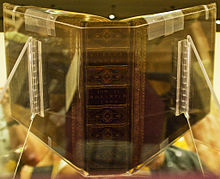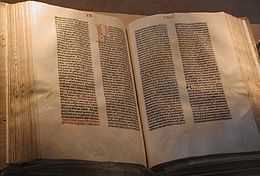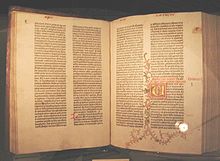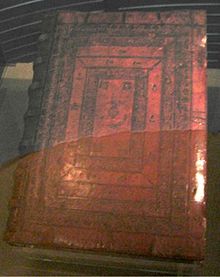- Gutenberg Bible
-
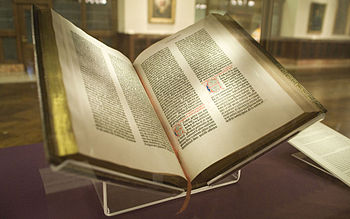 Gutenberg Bible of the New York Public Library, bought by James Lenox in 1847. The first to come to the USA, national folklore has it that the officers at the New York Customs House removed their hats on seeing it.
Gutenberg Bible of the New York Public Library, bought by James Lenox in 1847. The first to come to the USA, national folklore has it that the officers at the New York Customs House removed their hats on seeing it.
The Gutenberg Bible (also known as the 42-line Bible, the Mazarin Bible or the B42) was the first major book printed with a movable type printing press, and marked the start of the "Gutenberg Revolution" and the age of the printed book. Widely praised for its high aesthetic and artistic qualities,[1] the book has an iconic status. It is an edition of the Vulgate, printed by Johannes Gutenberg, in Mainz, Germany, in the 1450s. Only 21 complete copies survive, and they are considered by many sources to be the most valuable books in the world, even though a complete copy has not been sold since 1978.[2][3]
The 36-line Bible is also sometimes referred to as a Gutenberg Bible, but is possibly the work of another printer.
Contents
Relationship to earlier Bibles
In appearance the Gutenberg Bible closely resembles the large manuscript Bibles that were being produced at the time. The Giant Bible of Mainz, probably produced in Mainz in 1452-3, has been suggested as the particular model Gutenberg used.[4] Around this time large Bibles, designed to be read from a lectern, were returning to popularity for the first time since the twelfth century. In the intervening period, small hand-held Bibles had been usual.[5] The text of the Gutenberg Bible is traditional, falling within the Paris Vulgate group of texts.[6] Manuscript Bibles all had texts that differed slightly, and the copy used by Gutenberg as the exemplar for his Bible has not been discovered.[7]
Printing history
"All that has been written to me about that marvelous man seen at Frankfurt [sic] is true. I have not seen complete Bibles but only a number of quires of various books of the Bible. The script was very neat and legible, not at all difficult to follow—your grace would be able to read it without effort, and indeed without glasses."
The Bible was not Gutenberg's first work.[9] Preparation of it probably began soon after 1450, and the first finished copies were available in 1454 or 1455.[10] However, it is not known exactly how long the Bible took to print.
Gutenberg made three significant changes during the printing process.[11] The first sheets were rubricated by being passed twice through the printing press, using black and then red ink. This was soon abandoned, with spaces being left for rubrication to be added by hand.
Some time later, after more sheets had been printed, the number of lines per page was increased from 40 to 42, presumably to save paper. Therefore, pages 1 to 9 and pages 256 to 265, presumably the first ones printed, have 40 lines each. Page 10 has 41, and from there on the 42 lines appear. The increase in line number was achieved by decreasing the interline spacing, rather than increasing the printed area of the page.
Finally, the print run was increased, probably to 180 copies, necessitating resetting those pages which had already been printed. The new sheets were all reset to 42 lines per page. Consequently, there are two distinct settings in folios 1-32 and 129-158 of volume I and folios 1-16 and 162 of volume II.[11][12]
Our most reliable information about the Bible's date comes from a letter. In March 1455, future Pope Pius II wrote that he had seen pages from the Gutenberg Bible, being displayed to promote the edition, in Frankfurt.[13]
It is believed that in total 180 copies of the Bible were produced, 135 on paper and 45 on vellum.[14]
The production process: 'Das Werk der Bücher'
In a legal paper, written after completion of the Bible, Gutenberg refers to the process as 'Das Werk der Bücher': the work of the books. He had invented the printing press and was the first European to print with movable type.[15] But his greatest achievement was arguably demonstrating that the whole process of printing actually produced books.
Many book-lovers have commented on the high standards achieved in the production of the Gutenberg Bible, some describing it as one of the most beautiful volumes ever printed. The quality of both the ink and other materials and the printing itself have been noted.[1]
Paper and vellum
A single complete copy of the Gutenberg Bible has 1,272 pages; with 4 pages per folio-sheet, 318 sheets of paper are required per copy. The 45 copies printed on vellum required 11,130 sheets. The 135 copies on paper required 49,290 sheets of paper. The handmade paper used by Gutenberg was of fine quality and was imported from Italy. Each sheet contains a watermark, which may be seen when the paper is held up to the light, left by the papermold.
Pages
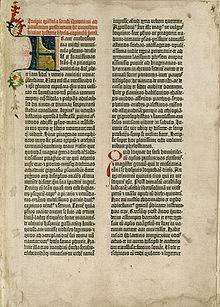 First page of the first volume: The Epistle of St. Jerome from the University of Texas copy. The page has 40 lines
First page of the first volume: The Epistle of St. Jerome from the University of Texas copy. The page has 40 lines
The paper size is 'double folio', with two pages printed on each side (four pages per sheet). After printing the paper was folded once to the size of a single page. Typically, five of these folded sheets (10 leaves, or 20 printed pages) were combined to a single physical section, called a quinternion, that could then be bound into a book. Some sections, however, had as few as 4 leaves or as many as 12 leaves.[16] Some sections may have been printed in a larger number, especially those printed later in the publishing process, and sold unbound. The pages were not numbered. The technique was not new, since it had been used to make blank "white-paper" books to be written afterwards. What was new was determining beforehand the correct placement and orientation of each page on the five sheets to result in the correct sequence when bound. The technique for locating the printed area correctly on each page was also new.
The folio size, 307 x 445 mm, has the ratio of 1.45:1. The printed area had the same ratio, and was shifted out of the middle to leave a 2:1 white margin, both horizontally and vertically. Historian John Man writes that the ratio was chosen to be close to the golden ratio of 1.61:1.[9] To reach this ratio more closely the vertical size should be 338 mm, but there is no reason why Gutenberg would leave this non-trivial difference of 8 mm go by in such a detailed work in other aspects.
Ink
In Gutenberg's time, inks used by scribes to produce manuscripts were water-based. Gutenberg developed an oil-based ink that would better adhere to his metal type. His ink was primarily carbon, but also had a high metallic content, with copper, lead, and titanium predominating.[17]
Type
The first part of the Gutenberg idea was using a single, hand-carved character to create identical copies of itself. Cutting a single letter could take a craftsman a day of work. A single page taking 2500 letters, crafting per page was unattainable. A less labour intensive method of reproduction was needed. Copies were produced by stamping the original into an iron plate, called a matrix. A rectangular tube was then connected to the matrix, creating a container in which molten type metal could be poured. Once cooled, the solid metal form was released from the tube. The fundamental innovation is that this matrix can be used to produce many duplicates of the same letter. The result of each molding was a rectangular block of metal with the form of the desired character protruding from the end. This piece of type could be put in a line, facing up, with other pieces of type. These lines were arranged to form blocks of text, which could be inked and pressed against paper, transferring the desired text to the paper.
Each unique character requires a master piece of type in order to be replicated. Given that each letter has uppercase and lowercase forms, and the number of various punctuation marks and ligatures (e.g. the sequence 'fi' combined in one character, commonly used in writing) the Gutenberg Bible needed a set of 290 master characters.
The scholar John Man has calculated the number of pieces of types required.[9] A single page has about 2600 characters. It seems probable that six pages, containing 15600 characters altogether, would be set at any one moment. Since it would take a craftsman a whole day to hand-cut type for one character, such a large number was probably produced through the mass-production of copies of one master-type.
Type style
The Gutenberg Bible is printed in the blackletter type styles that would become known as Textualis (Textura) and Schwabacher. The name texture refers to the texture of the printed page: straight vertical strokes combined with horizontal lines, giving the impression of a woven structure. Gutenberg already used the technique of justification, that is, creating a vertical, not indented, alignment at the left and right-hand sides of the column. To do this, he used various methods, including using characters of narrower widths, adding extra spaces around punctuation, and varying the widths of spaces around words.[18][19] On top of this, he subsequently let punctuation marks go beyond that vertical line, called Hanging punctuation, thereby using the massive black characters to make this justification stronger to the eye.
Rubrication, illumination and binding
Copies left the Gutenberg workshop unbound, without decoration, and for the most part without rubrication.
Initially the rubrics—the headings before each book of the Bible—were printed, but this experiment was quickly abandoned, and gaps were left for rubrication to be added by hand. A guide of the text to be added to each page, printed for use by rubricators, survives.[20]
The spacious margin allowed for illuminated decoration to be added by hand. The amount of decoration presumably depended on how much each buyer could or would pay for. Some copies were never decorated.[21] The place of decoration can be known or inferred for about 30 of the surviving copies. Perhaps 13 of these received their decoration in Mainz, but others were worked on as far away as London.[4] The vellum Bibles were more expensive and perhaps for this reason tend to be more highly decorated, although the vellum copy in the British Library is completely undecorated.[22] There has been speculation that the Master of the Playing Cards was partly responsible for the illumination of the Princeton copy, though all that can be said for certain is that the same model book was used for some of the illustrations in this copy and for some of the Master's playing cards.[23]
Although many Gutenberg Bibles have been rebound over the years, 9 copies retain fifteenth-century bindings. Most of these copies were bound in either Mainz or Erfurt.[4] Most copies were divided into two volumes, the first volume ending with The Book of Psalms. Copies on vellum were heavier and for this reason were sometimes bound in three or four volumes.[1]
Early owners
The Bible seems to have sold out immediately, with initial sales to owners as far away as England.[1] At least some copies are known to have sold for 30 florins.[24] Although this made them significantly cheaper than manuscript Bibles, most students, priests or other people of ordinary income would have been unable to afford them. It is assumed that most were sold to monasteries, universities and particularly wealthy individuals.[20] At present only one copy is known to have been privately owned in the fifteenth century. Some are known to have been used for communal readings in monastery refectories, others may have been for display rather than use, and a few were certainly used for study.[1] Kristian Jensen suggests that many copies were bought by wealthy and pious laypeople for donation to religious institutions.[22]
Influence on later Bibles
The Gutenberg Bible had an incalculable effect on the history of the printed book. Textually, it also had an influence on future editions of the Bible. It provided the model for the 36 Line Bible, while a Strasbourg edition of the Bible from 1470 is known to have been set from the copy now in Cambridge University Library. The Gutenberg Bible also had an influence on the Clementine edition of the Vulgate commissioned by the Papacy in the late sixteenth century.[7]
Surviving copies
As of 2009, 47 or 48 42-line Bibles are known to exist, but of these only 21 are complete. Others have leaves or even whole volumes missing. The figure of 48 copies counts separately the volumes in Trier and Indiana, which seem to be two pieces of the same copy. In addition, there are a substantial number of fragments, some as small as individual leaves.
There are twelve copies on vellum, although only four of these are complete and one is of the New Testament only.
The country with the most copies of any kind is Germany, which has twelve, while the United States has eleven, and the United Kingdom eight. New York has four copies, Paris and London have three each, and Mainz, the Vatican City and Moscow have two each. The country with the most complete copies is the United Kingdom with seven, the United States five, Germany three, and France two.
Institutions which have copies on permanent display include the Gutenberg Museum in Mainz, the British Library and the Library of Congress.
Copy numbers listed below are as found in the Incunabula Short Title Catalogue, taken from a 1985 survey of existing copies by Ilona Hubay; the two copies in Russia were not known to exist in 1985, and so were not catalogued.
Substantially complete copies of the 42-line Bible Country Holding institution Hubay
nbrlength material Notes,
Images,
ScansAustria (1) Österreichische Nationalbibliothek, Vienna 27 complete paper Belgium (1) Bibliothèque universitaire, Mons 1 incomplete paper Denmark (1) Kongelige Bibliotek, Copenhagen 12 incomplete paper Vol. II France (4) Bibliothèque nationale, Paris 15 complete vellum 17 incomplete paper Contains note by binder dating it to August 1456 Bibliothèque Mazarine, Paris 16 complete paper Bibliothèque Municipale, Saint-Omer 18 incomplete paper Germany (12) Gutenberg Museum, Mainz 8 incomplete paper One copy is vol. I; the other both vols. It is unclear which is which.
Online images of the 2 volume copy (German)9 Landesbibliothek, Fulda 4 incomplete vellum Vol. I Universitätsbibliothek, Leipzig 14 incomplete vellum Niedersächsische Staats-und Universitätsbibliothek, Göttingen 2 complete vellum Online images Staatsbibliothek, Berlin 3 incomplete vellum Bayerische Staatsbibliothek, Munich 5 complete paper Online images of vol. 1 vol. 2 (German) Universitätsbibliothek Johann Christian Senckenberg, Frankfurt am Main 6 complete paper Hofbibliothek, Aschaffenburg 7 incomplete paper Württembergische Landesbibliothek, Stuttgart 10 incomplete paper Purchased in April 1978 for 2.2 million US dollars. Stadtbibliothek, Trier 11 incomplete paper Vol. I?, Possibly sister volume to Hubay 46, in Indiana Landesbibliothek, Kassel 12 incomplete paper Vol. I Japan (1) Keio University Library, Tokyo 45 incomplete paper Vol. I, Purchased in October 1987 for either 4.9 or 5.4 million US dollars (sources disagree)
Online imagesPoland (1) Biblioteka Seminarium Duchownego, Pelpin 28 incomplete paper Online images of vol. 1 vol. 2 (Polish) Portugal (1) Biblioteca Nacional de Portugal, Lisbon 29 complete paper Russia (2) National Library of Russia, St Petersburg - incomplete vellum Moscow State University, Moscow - complete paper Spain (2) Biblioteca Universitaria y Provincial, Seville 32 incomplete paper New Testament only
Online images (Spanish)Biblioteca Pública Provincial, Burgos 31 complete paper Switzerland (1) Bibliotheca Bodmeriana, Cologny 30 incomplete paper United Kingdom (8) British Library, London ? complete vellum Online images ? complete paper Online images National Library of Scotland, Edinburgh 26 complete paper Online images Lambeth Palace Library, London 20 incomplete vellum New Testament only Eton College Library, Eton 23 complete paper John Rylands Library, Manchester 25 complete paper Online images of 11 pages Bodleian Library, Oxford 24 complete paper University Library, Cambridge 22 complete paper Online images of vol. 1 vol. 2 United States (11) The Morgan Library & Museum, New York 37 incomplete vellum 38 complete paper 44 incomplete paper Old Testament only
Online imagesLibrary of Congress, Washington DC 35 complete vellum Online images New York Public Library 42 incomplete paper 
Widener Library, Harvard University 40 complete paper Beinecke Library, Yale University 41 complete paper Scheide Library, Princeton University 43 paper Lilly Library, Indiana University 46 incomplete paper Possibly sister volume to Hubay 11, in Trier Henry E. Huntington Library, San Marino, CA 36 incomplete vellum Harry Ransom Humanities Research Center, University of Texas at Austin 39 complete paper Purchased in 1978 for 2.4 million US dollars.
Online imagesVatican City (2) Bibliotheca Apostolica Vaticana 33 incomplete vellum 34 incomplete paper Vol I Recent history
Today, few copies remain in religious institutions, with most now owned by university libraries and other major scholarly institutions. After centuries in which all copies seem to have remained in Europe, the first Gutenberg Bible reached North America in 1847. It is now in the New York Public Library.[25]
One copy was lost during the destruction of the library of the Catholic University of Leuven by German troops in 1914.
In the 1920s a New York book dealer, Gabriel Wells, bought a damaged paper copy, dismantled the book and sold sections and individual leaves to book collectors and libraries. The leaves were sold in a portfolio case with an essay written by A. Edward Newton.[26] (Also referred to as a "Noble Fragment") These leaves now sell for $20,000–$100,000 depending upon condition and the desirability of the page.
During the Second World War the Red Army removed two copies from Leipzig. Their whereabouts were unknown for many years until it was revealed they were in Moscow.[25]
The last sale of a complete Gutenberg Bible took place in 1978. It fetched $2.2 million. This copy is now in Stuttgart.[25]
The only copy held in a non-western country is the first volume of a Gutenberg Bible (Hubay 45) at Keio University (Tokyo, Japan) - originally purchased 22 October 1987 by Eiichi Kobayashi, a director at the Maruzen Company, for $5.4 million.[27] The HUMI Project team at Keio University is known for its digital imaging work.[28]
The price of a complete copy today is estimated at $25−35 million.[2][3]
See also
- For other works printed by Gutenberg or from the workshop he founded, See: Johannes Gutenberg.
- Incunable
- 36 Line Bible
- Printing press
Notes
- ^ a b c d e Davies, Martin (1996). The Gutenberg Bible. British Library. ISBN 0712304924.
- ^ a b MSNBC: In the book world, the rarest of the rare
- ^ a b Luxist.com: The World of Rare Books: The Gutenberg Bible, First and Most Valuable
- ^ a b c Estes, Richard (2005). The 550th Anniversary Pictorial Census of the Gutenberg Bible. Gutenberg Research Center. p. 151.
- ^ de Hamel, Christopher (2001). The Book: a History of the Bible. Phaidon Press. p. 194. ISBN 0714837741.
- ^ British Library, The text of the Bible accessed 4 July 2009
- ^ a b Needham, Paul (1999). "The Changing Shape of the Vulgate Bible in Fifteenth-Century Printing Shops". In Saenger, Paul and Van Kampen, Kimberly. The Bible as Book:the First Printed Editions. British Library. pp. 53–70. ISBN 0712346015.
- ^ Childress 2008, p. 62
- ^ a b c Man, John (2002). Gutenberg: How One Man Remade the World with Words. New York: John Wiley and Sons, Inc.. ISBN 0-471-21823-5.
- ^ University of Texas -The Gutenberg Bible
- ^ a b British Library, Three phases in the printing process accessed 4 July 2009
- ^ British Library, The differences in line lengths per page: pictures showing differences between differences between the Keio copy (40 lines per page) and the British Library copy (42 lines per page) in Genesis 1. Accessed 10 July 2009
- ^ British Library, Gutenberg's life: the years of the Bible accessed 10 July 2009
- ^ British Library, Making the Bible: how many accessed 21 February 2010
- ^ British Library, Gutenberg Bible: background accessed 10 July 2009
- ^ British Library, Making the Bible: the gatherings accessed 10 July 2009
- ^ British Library, Making the Bible: the ink accessed 18 October 2009.
- ^ Television presentation, "The Machine that Made Us", presenter: Stephen Fry
- ^ TORBJØRN ENG, "InDesign, the hz-program and Gutenberg's secret",http://www.typografi.org/justering/gut_hz/gutenberg_hz_english.html, retrieved 8 Oct 2009
- ^ a b Kapr, Albert (1996). Johann Gutenberg: The Man and His Invention. Scolar Press. ISBN 1-85928-114-1.
- ^ British Library, The copy on paper - decoration, accessed 18 October 2008.
- ^ a b Jensen, Kristian (2003). "Printing the Bible in the fifteenth century: devotion, philology and commerce". In Jensen, Kristian. Incunabula and their readers: printing, selling and using books in the fifteenth century. British Library. pp. 115–38. ISBN 0712347690.
- ^ Anne H. van Buren, Sheila Edmunds: Playing Cards and Manuscripts: Some Widely Disseminated Fifteenth Century Model Sheets, In: The Art Bulletin 56. March 1974, p.12-30, ISSN 0004-3079
- ^ Cormack, Lesley B.; Ede, Andrew (2004). A History of Science in Society: From Philosophy to Utility. Broadview Press. ISBN 1-55111-332-5.
- ^ a b c Clausen Books Gutenberg Bible Census accessed 7 July 2009
- ^ Kenyon College Library http://lbis.kenyon.edu/sca/exhibits/incunabula/z241b58.phtml
- ^ New York Times
- ^ "The Gutenberg Bible Online Digital Facsimile", Keio University
External links
- Treasures in Full: Gutenberg Bible Information about Gutenberg and the Bible as well as online images of the British Library's 2 copies
- Gutenberg Bible Informative website including images of the copy at the University of Texas at Austin
- Gottingen copy of the Gutenberg Bible Includes images of the Bible and some interesting related documents
- The Morgan Gutenberg Bible Online
- Incunabula Short Title Catalogue Entry for Gutenberg Bible
- Gutenberg Bible Census Details of surviving copies, including some notes on provenance
- Tabula rubricarum (German) Image of rubricators' instructions from the Munich copy
- The Gutenberg Bible at the Beinecke Podcast from the Beinecke Library, Yale University
- McCune Collection Image and information about a single leaf held by the McCune Collection
Categories:- 1450s books
- Early printed Bibles
- 15th-century Christian texts
- Incunabula
- Mainz
- Memory of the World Register
- Johannes Gutenberg
Wikimedia Foundation. 2010.

